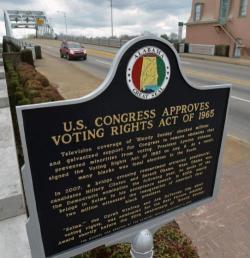The First March from Selma to Montgomery - 50th Anniversary
It was fifty years ago today that a protest march was organized in response to the fatal shooting of protester Jimmie Lee Jackson by an Alabama State Trooper on February 17, 1965. Jackson was protesting outside the Dallas County, Alabama courthouse to bring national attention to the resistance of black voting. That march was intended to be a peaceful protest. The route went from Selma to Montgomery crossing the Alabama River over the Edmund Pettus Bridge.
 The 600 protesters led by John Lewis were blocked just short of the bridge by the Alabama State Troopers and local police and told to turn around. When they refused the police fired teargas into the crowd and attacked the protestors with billy clubs. Over 50 people were hospitalized, many with serious injuries. This image from the public domain shows Lewis being beaten. It’s not hard to understand why it was dubbed “Bloody Sunday.”
The 600 protesters led by John Lewis were blocked just short of the bridge by the Alabama State Troopers and local police and told to turn around. When they refused the police fired teargas into the crowd and attacked the protestors with billy clubs. Over 50 people were hospitalized, many with serious injuries. This image from the public domain shows Lewis being beaten. It’s not hard to understand why it was dubbed “Bloody Sunday.”
Martin Luther King, Jr. called for another protest march on the ninth. He was under pressure from Washington to restrain the march until a federal court could rule if the protestors were entitled to federal protection, but he was also under pressure from the Student Nonviolent Coordinating Committee who were leading the efforts to register voters to continue. The march was held but the bridge was blocked again. This time King turned back. On March 21 there was a successful march with federal protection.
 The Voting Rights Act was passed by Congress the following August but information about how much pressure King was getting from all sides did not emerge until much later.
The Voting Rights Act was passed by Congress the following August but information about how much pressure King was getting from all sides did not emerge until much later.
President Obama is scheduled to deliver an address today at a marker erected earlier this year by the Alabama State Tourism Department at the foot of the Pettus Bridge.
Please join me in a moment of reflection and ponder what happened that day, what has changed since then, and what hasn't.


Comments
I remember that day
I was only seventeen, but I had been deeply involved in the civil rights movement for sometime. I am very saddened by recent events that suggest we are falling backward and not moving forward on race relationshiips.
Nice post.
praenomen
I heard John Lewis
speak at an event during the '08 DNC convention in Denver. I was sitting very close to him. He had a look of fear in his eyes when he spoke of Bloody Sunday. And he looked close to tears when he spoke of the potential and meaning of electing the first black president. I often wonder what he thinks these days because I agree with you that we are moving backward.
"Never separate the life you live from the words you speak." --Paul Wellstone
I just finished reading "The Fierce Urgency of Now"
The author is Julian Zelizer, a history professor from Princeton. He makes the argument that as committed as Lyndon Johnson was to end discrimination and policy, he benefitted from one factor beyond his control and one factor partially beyond his control.
The factor beyond Johnson's control was Dr. Martin Luther King, who consciously adopted a strategy of confronting white officials in the South. King got what he wanted--video of white cops attacking non-violent demonstrators, which shocked the country. Bloody Sunday ensured that the Voting Rights Act would pass.
The factor partially beyond Johson's control was Barry Goldwater, who decided to run as a movement conservative and take deeply unpopular positions, which included getting rid of Social Security. The result was a Democratic landslide in 1964 and the most liberal Congress since FDR's first term.